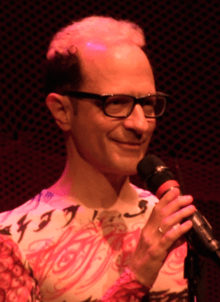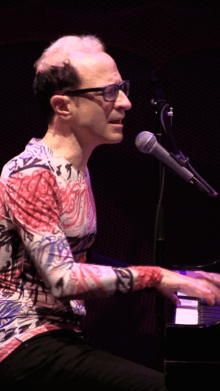Wayne Koestenbaum
Wayne Koestenbaum (born 1958) is an American poet and cultural critic. He received a B.A. from Harvard University, an M.A. from the Johns Hopkins Writing Seminars, and a Ph.D. from Princeton University. Currently, he lives in New York City, where he is Distinguished Professor of English at the City University of New York Graduate Center. He is Jewish.[1]

Koestenbaum works as a Distinguished Professor of English at the CUNY Graduate Center,[2] where he taught Maggie Nelson[3]
Critical work
In Boston Review, Stefania Heim wrote that Koestenbaum's work —across genre— "obliterates any vestigial divide we might hold on to between play and thought. It revels in and broadcasts the risks and joys ( the risky joys and joyful risks) inherent in both."[4] Koestenbaum's rhapsodic criticism—containing autobiographical asides, and characterized by an analytic attention to small details, an approach indebted to Roland Barthes's theory of the "punctum"—focuses on celebrity, performance, poetics, film, contemporary visual art, and queer sexuality.[5] [6]His best-known critical book, The Queen's Throat, is a rigorous exploration of a phenomenon frequently discussed casually but seldom considered from a scholarly viewpoint: the predilection of gay men for opera. Koestenbaum's claim is that opera derives its power from a kind of physical sympathy between singer and audience that has as much to do with desire as with hearing. He says of the act of listening:
- The dance of sound waves on the tympanum, and the sigh I exhale in sympathy with the singer, persuade me that I have a body—if only by analogy, if only a second-best copy of the singer's body. I'm a lemming, imprinted by the soprano, my existence an aftereffect of her crescendo. (42)
Koestenbaum's conclusion is that gay men's affinity for opera tells us as much about opera and its inherent questions about masculinity as it does about homosexuality.
Humiliation, Koestenbaum's critically acclaimed disquisition on the meaning of humiliation (both personal and universal), was praised by John Waters as "the funniest, smartest, most heartbreaking yet powerful book I've read in a long time."[7] Koestenbaum starred in a web series in support of this book, "Dear Wayne, I've Been Humiliated...", which was dubbed "the mother of all book trailers" by The New York Observer.[8]
Koestenbaum's 2012 book The Anatomy of Harpo Marx was met with mixed reviews. Brian Dillon praised the book in Sight and Sound as "charming and rigorous"[9] and lauded the book in Frieze as an "excellent example of a kind of delirious scholarship." [10] In New Haven Review, Jonathan Kiefer described the book as “a zesty and deeply literate joy to read. Just as his previous nonfiction work, Humiliation, seemed like an apotheosis of new literary possibility in the age of overshare, so Koestenbaum's new book reinvigorates film studies."[11]'Writing in the San Francisco Chronicle, Saul Austerlitz suggested that Koestenbaum "sexualizes Harpo beyond all recognition, creating a figure about whom the author can say, in all seriousness, that 'courtesy of the anus, we can imagine, Marxist-style, a path away from family and state.'"[12] Joe Queenan, citing Koestenbaum's claim that Harpo Marx "has many vaginas," wrote that Koestenbaum "peppers his story with just enough tidbits of fascinating information that readers may fleetingly overlook the fact that his theories are barmy."[13]
Koestenbaum has published many essays, often lyrical or experimental in style, on such subjects as celebrity, classical music, contemporary art, literature, and aesthetics; some of these essays have been collected in the books, Cleavage: Essays on Sex, Stars, and Aesthetics, and My 1980s & Other Essays, and Figure It Out: Essays
Poetry
Koestenbaum's poetry is often more measured than his criticism. It frequently comments on itself—on the disorderly process of poetry—as in "Men I Led Astray" (from The Milk of Inquiry):
- I haven't said enough about the ragged sun,
its satisfaction in being the one to bind my life—
to bring the filthy pieces together,
on its way to more important tasks.
Koestenbaum's first book, Ode to Anna Moffo and Other Poems, was composed largely in syllabic verse and other fixed forms. In a review of Ode to Anna Moffo and Other Poems for Poetry Magazine, David Baker wrote that "[Koestenbaum] is... willing to exert the pressures of traditional formality, yet he is also likely to let the voice and experience of a poem grate against his own formal gestures..."[14] His subsequent books of poetry took on a more experimental approach to prosody. He returned to fixed forms for his book-length poem, Model Homes, which is composed in ottava rima.[15] His two most recent books, The Pink Trance Notebooks and Camp Marmalade, are experiments in what Koestenbaum refers to as trance writing. Ben Shields described trance writing in The Paris Review as an approach that "allows language to move freely" and "does not often adhere to expected thematic, syntactic, or logical patterns."[16] Publishers Weekly described the work in The Pink Trance Notebooks as "look[ing] and feel[ing] like the cut-and-paste fragments of a journal."[17]
Painting
.png)
Koestenbaum began to paint in 2010 and has had three solo exhibitions (White Columns,[18] the Art Museum at the University of Kentucky in Lexington,[19] and 356 Mission [20]). In a 2016 Art News article, Ella Coon wrote that "his early work was figurative, and influenced by Warhol. He used a monoprint technique to trace images of male nudes, which he’d originally drawn from life, onto a black ground."[21] In Hyperallergic, his exhibition at the Art Museum at the University of Kentucky in Lexington was described as " all smack of bright, unblended color, sexuality, and a heavy concentration on line and ornamentation — qualities that speak to the artist’s admiration for modernists like André Derain, Henri Matisse, and Marsden Hartley."[22]
Awards
- 1994 Whiting Award
- 1989 Co-winner of 1989 Discovery/The Nation Poetry Award[23]
Bibliography

Poetry
- Ode to Anna Moffo and Other Poems (Persea, 1990).
- Rhapsodies of A Repeat Offender (Persea, 1994).
- The Milk of Inquiry (Persea, 1999).
- Model Homes (BOA Editions, 2004).
- Best-Selling Jewish Porn Films (Turtle Point Press, 2006).
- Blue Stranger With Mosaic Background (Turtle Point Press, 2012).
- The Pink Trance Notebooks (Nightboat Books, 2015).
- Camp Marmalade (Nightboat Books, 2018).
Criticism
- Double Talk: The Erotics of Male Literary Collaboration (Routledge, 1989).
- The Queen's Throat: Opera, Homosexuality, and the Mystery of Desire (Poseidon, 1993).
- Jackie Under My Skin: Interpreting An Icon (Farrar, Straus, and Giroux, 1995).
- Cleavage: Essays on Sex, Stars, and Aesthetics (Ballantine Books, 2000).
- Andy Warhol (Lipper/Viking, 2001).
- Humiliation (Picador, 2011).
- The Anatomy of Harpo Marx (University of California Press, 2012).
- My 1980s and Other Essays (Farrar, Straus, and Giroux, 2013)
- Notes on Glaze: 18 Photographic Investigations (Cabinet Books, 2016).
- Figure It Out, Essays (Soft Skull Press, 2020).
Fiction
- Moira Orfei in Aigues-Mortes (Soft Skull, 2004).
- Hotel Theory (Soft Skull Press, 2007).
Opera libretto
Lyric Essay
- (The Task of the Translator, Fall 2003)
References
- https://bombmagazine.org/articles/wayne-koestenbaum/
- "WAYNE KOESTENBAUM". The Graduate Center. CUNY. Retrieved 13 May 2020.
- Als, Hilton (18 April 2016). "Immediate Family". The New Yorker. Condé Nast. Retrieved 13 May 2020.
'She found a friendship with her instabilities and turned it immediately into questions that are dazzled, rather than narcotized,' the writer Wayne Koestenbaum, with whom Nelson studied at cuny, told me.
- Heim, Stefania. "Future Doors". Boston Review.
- Firth, Andy. "Having Glaze Both Ways: Talking to Wayne Koestenbaum". Los Angeles Review of Books.
- Koestenbaum, Wayne. "Q/A Wayne Koestenbaum". Spike Art Magazine.
- Waters, John. "Praise for Humiliation". Macmillan Web Site. Picador. Retrieved 13 July 2011.
- Miller, Michael (11 July 2011). "Wayne Koestenbaum Will Help You Cope with Your Humiliation". The New York Observer. Retrieved 13 July 2011.
- Dillon, Brian. "Harpo Speaks".
- Dillon, Brian. "Energy and Rue".
- Kiefer, Jonathan. "New Haven Review".
- "'The Anatomy of Harpo Marx': review".
- "The Anatomy of Harpo Marx, by Wayne Koestenbaum" – via The Globe and Mail.
- David, Baker. "Culture, Inclusion, Craft". Poetry Magazine.
- "Model Homes".
- Shields, Ben. "I'm the Marmalade: An Interview with Wayne Koestenbaum". The Paris Review.
- "Pink Trance Notebook".
- "White Room by Wayne Koestenbaum". White Columns.
- "WAYNE KOESTENBAUM: Unfamiliar Grammar, Paintings from 2010-2015". University of Kentucky College of Fine Arts.
- "Wayne Koestenbaum: A Novel of Thank You and Other Paintings". 365 Mission.
- "'When Perverted Looking Becomes a Home': How the Indefatigable Writer Wayne Koestenbaum Became a Painter". Art News.
- "The Visceral Visual Art of Writer Wayne Koestenbaum". Hyperallergic.
- "Wayne Koestenbaum". Poets.
External links
- The Graduate Center, CUNY Faculty Page
- Interview in Guernica
- Interview in Bomb Magazine
- Bomb: The Author Interviews Bomb
- Profile at The Whiting Foundation
- "Outside In" via Triple Canopy (online magazine)
- Interview in Bookforum
- Profile in The Face
- Profile in Art News
- Profile in Hyperallergic
- Interview in Boston Review
- Wayne Koestenbaum Website
- Interview in Frieze